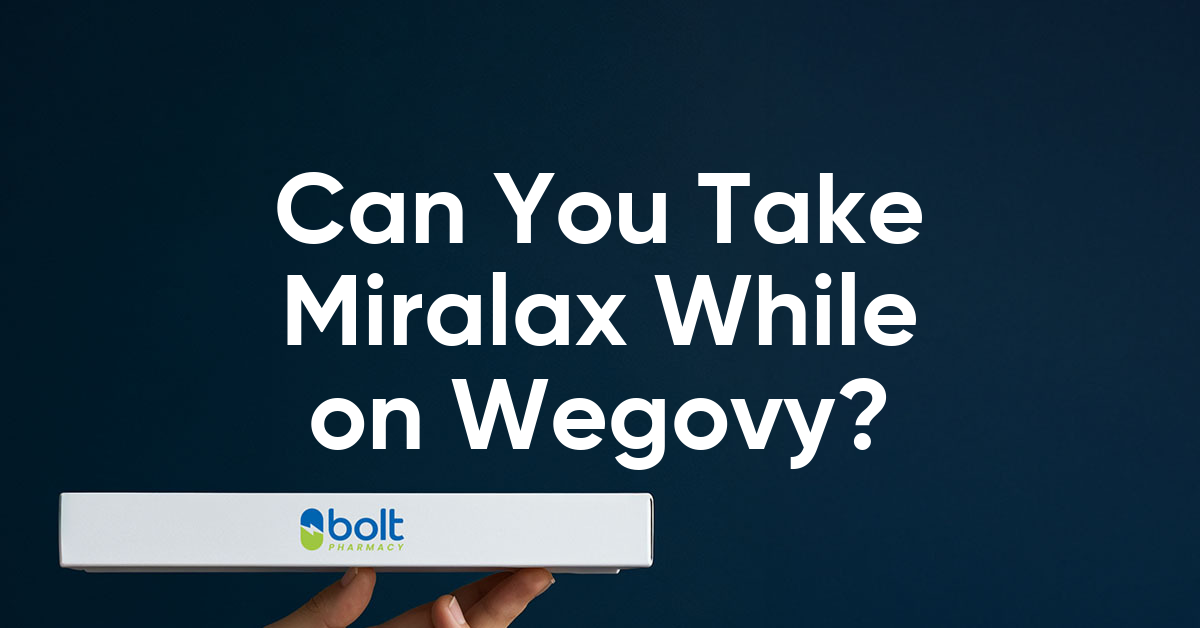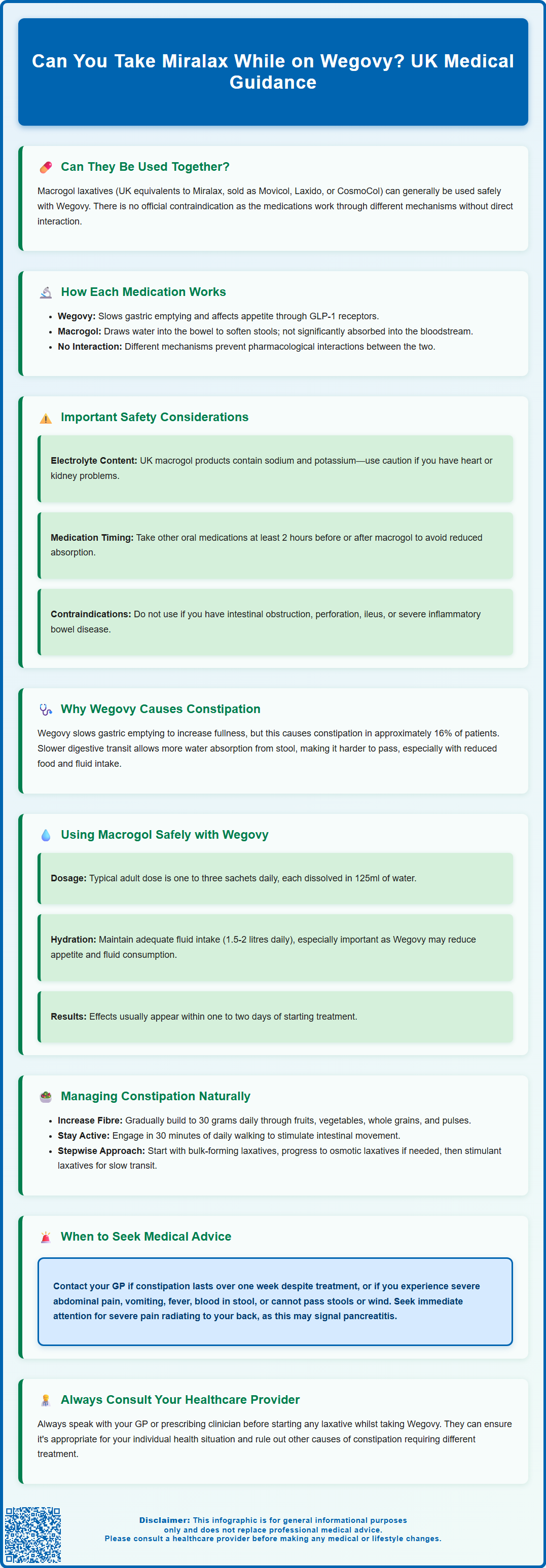Wegovy®
A weekly GLP-1 treatment proven to reduce hunger and support meaningful, long-term fat loss.
- ~16.9% average body weight loss
- Boosts metabolic & cardiovascular health
- Proven, long-established safety profile
- Weekly injection, easy to use

For individuals taking Wegovy (semaglutide) who experience constipation, questions about using laxatives safely are common. In the UK, macrogol 3350 (polyethylene glycol) products—available as Movicol, Laxido, and CosmoCol—are the equivalent of US Miralax. According to product SmPCs, there is no contraindication to using macrogol-based osmotic laxatives alongside Wegovy. These medications work through different mechanisms without direct pharmacological interaction. Wegovy, a GLP-1 receptor agonist for weight management, slows gastric emptying, whilst macrogol draws water into the bowel to soften stools. However, individual circumstances vary, and consulting your GP or prescribing clinician before starting any laxative whilst on Wegovy remains essential for safe, personalised care.
Summary: Macrogol laxatives (UK equivalent of Miralax) can generally be used safely alongside Wegovy, as there is no contraindication and the medications work through different mechanisms without direct interaction.
For individuals taking Wegovy (semaglutide) who experience constipation, the question of whether laxatives such as Miralax can be used safely is common. In the UK, Miralax is not licensed; the equivalent products are macrogol 3350 (polyethylene glycol) laxatives, available under brand names including Movicol, Laxido, and CosmoCol. According to the Wegovy and macrogol product SmPCs, there is no official contraindication to using macrogol-based osmotic laxatives whilst taking Wegovy, and these medications work through different mechanisms that do not directly interact at a pharmacological level.
Wegovy is a glucagon-like peptide-1 (GLP-1) receptor agonist licensed for weight management in adults with obesity or overweight with weight-related comorbidities. Macrogol laxatives function as osmotic agents, drawing water into the bowel to soften stools and promote regular bowel movements. Because macrogol is not systemically absorbed to any significant degree and Wegovy acts primarily through GLP-1 receptors affecting appetite regulation and gastric emptying, there is no known pharmacokinetic interaction between these agents.
It's important to note that UK macrogol products typically contain electrolytes (unlike US MiraLAX), which may be relevant for patients on sodium-restricted diets or with heart or renal impairment. Macrogol is contraindicated in intestinal obstruction, perforation, ileus, and severe inflammatory bowel disease. Additionally, macrogol may transiently reduce absorption of other oral medications taken concurrently.
It remains essential to consult with your GP or prescribing clinician before starting any new medication, including over-the-counter laxatives, whilst on Wegovy. Individual circumstances vary, and your healthcare provider can assess whether macrogol is appropriate for your specific situation, consider alternative causes of constipation, and ensure that symptom management aligns with your overall treatment plan.
Wegovy exerts its therapeutic effects through activation of GLP-1 receptors located throughout the body, including the gastrointestinal tract. This mechanism of action directly influences digestive function in several ways. GLP-1 receptor agonists slow gastric emptying, meaning food remains in the stomach for longer periods before passing into the small intestine. This delayed emptying contributes to increased satiety and reduced appetite, which are central to Wegovy's effectiveness in weight management. However, this same mechanism can lead to various gastrointestinal side effects.
Constipation is a recognised adverse effect of Wegovy, reported in clinical trials at varying frequencies depending on dose. According to the MHRA/EMC SmPC for Wegovy, gastrointestinal disorders are very common (≥1/10 patients), with constipation specifically affecting approximately 16% of patients in pivotal trials. The slowed transit time through the digestive system means that stool remains in the colon for extended periods, allowing more water to be absorbed and resulting in harder, more difficult-to-pass stools. Additionally, patients taking Wegovy typically reduce their food and fluid intake as appetite decreases, which can further contribute to constipation if dietary fibre and hydration are not maintained at adequate levels.
Other common gastrointestinal effects include nausea, vomiting, diarrhoea, abdominal pain, and dyspepsia. These symptoms are generally most pronounced during the initial titration phase when the dose is being gradually increased. The Wegovy SmPC recommends gradual dose escalation to minimise gastrointestinal adverse effects. Most patients find that gastrointestinal side effects diminish over time as the body adapts to the medication.
Rare but serious gastrointestinal risks associated with GLP-1 receptor agonists include intestinal obstruction and ileus. Additionally, rapid weight loss and GLP-1 therapy may increase the risk of gallbladder disease, including gallstones. Understanding how Wegovy affects the digestive system helps patients and clinicians anticipate potential issues and implement appropriate management strategies from the outset of treatment.

When considering the use of macrogol laxatives (the UK equivalent of Miralax) alongside Wegovy or other GLP-1 receptor agonists, several practical considerations ensure safe and effective management. Macrogol products work by retaining water in the bowel through osmotic action, increasing stool volume and softness without stimulating the bowel wall. This gentle mechanism makes them suitable for regular use and generally well-tolerated, even in patients with altered gastrointestinal motility.
The typical adult dose of macrogol 3350 for constipation is one to three sachets daily, as specified in the BNF and product SmPCs. Each sachet should be dissolved in 125ml of water before consumption. It is important to maintain adequate fluid intake when using osmotic laxatives, as they require sufficient water to function effectively. Patients on Wegovy should be particularly mindful of hydration, as reduced appetite may inadvertently lead to decreased fluid consumption. Ensuring overall daily fluid intake of approximately 1.5 to 2 litres supports both laxative efficacy and general wellbeing during weight management treatment.
Timing of administration may be relevant for some patients. While there is no requirement to separate macrogol from Wegovy doses (which are administered weekly by subcutaneous injection), macrogol may transiently reduce absorption of other oral medications. For medicines where absorption is clinically important, consider taking them at least 2 hours before or after macrogol. Some individuals find that taking the laxative at a consistent time each day—such as in the morning—helps establish a regular bowel routine.
Patients should be aware that macrogol typically produces results within one to two days, though this may vary. UK macrogol products contain sodium and potassium, which should be considered for patients with renal impairment, heart failure, or those on restricted diets. If constipation persists despite appropriate laxative use, or if symptoms worsen, medical review is warranted to exclude other contributing factors or complications.
Effective management of constipation whilst taking Wegovy involves a comprehensive approach that extends beyond laxative use alone. Dietary modification forms the foundation of constipation prevention and treatment. The Scientific Advisory Committee on Nutrition (SACN) recommends increasing dietary fibre intake to approximately 30 grams daily through consumption of fruits, vegetables, whole grains, pulses, and nuts, which can significantly improve bowel regularity. However, fibre intake should be increased gradually to avoid bloating and discomfort, and must be accompanied by adequate fluid intake to be effective.
Physical activity plays an important role in maintaining healthy bowel function. Regular exercise stimulates intestinal motility and can help counteract the slowed transit time associated with GLP-1 medications. Even moderate activity such as daily walking for 30 minutes can provide benefit. Establishing a regular toilet routine, allowing adequate time for bowel movements without rushing, and responding promptly to the urge to defecate all support normal bowel habits.
When lifestyle measures prove insufficient, NICE Clinical Knowledge Summary (CKS) on constipation recommends a stepwise approach to laxative therapy based on stool consistency and individual factors. For chronic constipation with hard stools, bulk-forming laxatives such as ispaghula husk may be tried initially, though these require good hydration and may exacerbate bloating in some patients. Osmotic laxatives like macrogol are often appropriate for hard stools or when bulk-forming agents are ineffective or unsuitable. Stimulant laxatives such as senna or bisacodyl may be added for slow transit or when stools are soft but difficult to pass. Importantly, if faecal impaction is suspected, this should be cleared (often with high-dose macrogol regimen) before increasing fibre or using bulk-forming agents.
Patients should maintain open communication with their healthcare team about bowel symptoms. Dose adjustment of Wegovy may occasionally be necessary if gastrointestinal side effects become intolerable or significantly impact quality of life. In some cases, temporary dose reduction followed by slower re-titration can allow better tolerance whilst maintaining therapeutic benefit. Monitoring for adequate nutritional intake, particularly of fibre and fluids, should form part of routine follow-up during Wegovy treatment.
Whilst constipation is a common and generally manageable side effect of Wegovy, certain symptoms warrant prompt medical evaluation. Patients should contact their GP or prescribing clinician if constipation persists for more than one week despite appropriate laxative use and lifestyle measures, or if there is complete inability to pass stools or wind, which may indicate bowel obstruction. Severe or worsening abdominal pain, particularly if accompanied by distension, vomiting, or fever, requires urgent assessment as these may signal complications.
The presence of rectal bleeding or blood in the stool should always be investigated, as this is not an expected effect of either Wegovy or macrogol laxatives and may indicate other pathology requiring diagnosis. Similarly, an unexpected pattern or rate of weight loss beyond that anticipated with Wegovy treatment, or constitutional symptoms such as persistent fatigue or night sweats, merit clinical review. Changes in bowel habit that represent a significant departure from an individual's normal pattern, particularly in those over 60 years or with family history of colorectal cancer, should be evaluated in accordance with NICE guideline NG12 on suspected cancer recognition and referral.
Patients experiencing severe nausea, persistent vomiting, or signs of dehydration whilst taking Wegovy should seek medical advice, as these symptoms may necessitate treatment adjustment or temporary discontinuation. Right upper quadrant pain, fever, or jaundice may indicate gallbladder disease, which is associated with GLP-1 therapy and rapid weight loss, and requires prompt assessment. Symptoms suggestive of pancreatitis—severe, persistent abdominal pain radiating to the back, often accompanied by vomiting—require immediate medical attention, as acute pancreatitis is a rare but serious potential adverse effect of GLP-1 receptor agonists. For severe symptoms, contacting NHS 111 or attending urgent care/emergency department may be appropriate.
It is important to inform healthcare providers of all medications being taken, including over-the-counter products and supplements, as comprehensive medication review helps identify potential interactions or contributing factors to symptoms. Regular follow-up appointments during Wegovy treatment provide opportunity to discuss any concerns about digestive function and ensure that weight management proceeds safely and effectively. Patients should never hesitate to seek advice if uncertain about symptoms, as early intervention can prevent complications and optimise treatment outcomes.
Yes, macrogol laxatives (Movicol, Laxido, CosmoCol) can generally be used safely with Wegovy as there is no contraindication and they work through different mechanisms. However, always consult your GP or prescribing clinician before starting any new medication.
Wegovy slows gastric emptying through GLP-1 receptor activation, which increases satiety but also slows digestive transit time. This allows more water absorption from stool in the colon, resulting in harder, more difficult-to-pass stools.
The UK equivalent of Miralax is macrogol 3350 (polyethylene glycol), available under brand names including Movicol, Laxido, and CosmoCol. Unlike US Miralax, UK macrogol products typically contain electrolytes.
The health-related content published on this site is based on credible scientific sources and is periodically reviewed to ensure accuracy and relevance. Although we aim to reflect the most current medical knowledge, the material is meant for general education and awareness only.
The information on this site is not a substitute for professional medical advice. For any health concerns, please speak with a qualified medical professional. By using this information, you acknowledge responsibility for any decisions made and understand we are not liable for any consequences that may result.
Lorem ipsum dolor sit amet, consectetur adipiscing elit, sed do eiusmod tempor incididunt ut labore et dolore magna aliqua. Ut enim ad minim veniam, quis nostrud exercitation ullamco laboris nisi ut aliquip ex ea commodo consequat. Duis aute irure dolor in reprehenderit in voluptate velit esse cillum dolore eu fugiat nulla pariatur.
Block quote
Ordered list
Unordered list
Bold text
Emphasis
Superscript
Subscript